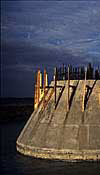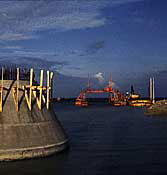
Offshore
Foundations: Traditional Concrete

Photograph © 1996 by
Flemming Hagensen

Vindeby and Tunoe Knob Offshore Wind Farms
Vindeby Offshore Wind Farm and Tunoe Knob Wind Farm are examples of this traditional foundation technique. The caisson foundations were built in dry dock near the sites using armed concrete and were floated to their final destination before being filled with sand and gravel to achieve the necessary weight. The principle is thus much like that of traditional bridge building.
Disadvantage of Concrete
Using traditional concrete foundation techniques the cost of the completed foundation is approximately proportional with the water depth squared - the quadratic rule.
![]()
|
Back | Home
| Forward |
© Copyright 2000 Soren Krohn.
All rights reserved.
Updated 9 September 2000
http://www.wind power.dk/tour/rd/concrete.htm